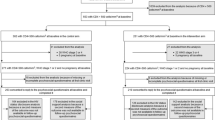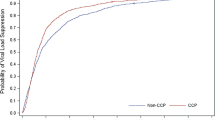Abstract
Persons receiving effective HIV treatment experience longevity and improvement in quality of life. For those infected, social support is associated with improved medication adherence. Disclosure of infection status is likely a prerequisite for social support. However, little research describes patterns of HIV disclosure by infected persons. We retrospectively evaluated factors associated with disclosure among patients initiating HIV care at a university-based clinic from 2007 to 2012. Of 490 persons initiating care, 13 % had not disclosed their HIV infection to anyone. Black race significantly predicted non-disclosure and persons living with a significant other or friends were more likely to have disclosed their HIV infection versus those living alone. CD4 + T lymphocyte count <200 was associated with nondisclosure and disclosure only to family members. Future research is needed to better understand factors associated with disclosure of HIV infection status, because this could enhance receipt of social support and contribute to improved HIV health outcomes.
Resumen
Las personas que reciben tratamiento para el VIH tienen mejorías en la calidad de vida y sobrevida. Para las personas infectadas, el apoyo social se asocia con una mejor adherencia a la medicación. La divulgación del diagnóstico a familiares o amigos es probablemente un requisito un apoyo social eficaz. Sin embargo, pocos estudios describen los patrones de divulgación del diagnóstico de VIH en personas infectadas. Evaluamos retrospectivamente los factores asociados a la divulgación entre los pacientes que inician cuidado de VIH en un consultorio afiliado a una universidad, entre el 2007 y 2012. De 490 personas que iniciaron el cuidado de VIH, el 13 % no había revelado su diagnóstico a nadie. El ser de raza negra predijo significativamente la no divulgación, y aquellos que Vivian con su pareja o amigos tuvieron más probabilidades de haber revelado su diagnóstico en comparación con los que vivían solos. El recuento de CD4 < 200 estuvo asociado a la no divulgación del diagnóstico y la revelación sólo a miembros de la familia. Se necesitara hacer más estudios en el futuro para comprender mejor los factores asociados a la divulgación del diagnóstico de infección por VIH, ya que esto podría mejorar las posibilidades de apoyo social y contribuir a mejorar la salud de pacientes con VIH.
Similar content being viewed by others
Referrences
Centers for Diease Control and Prevention. HIV/AIDS surveillance report, 2008. vol 20. Atlanta, GA: US Department of Health and Human Services, Centers for Disease Control and Prevention; 2009.
Ammassari A, Trotta MP, Murri R, Castelli F, Narciso P, Noto P, et al. Correlates and predictors of adherence to highly active antiretroviral therapy: overview of published literature. J Acquir Immune Defic Syndr. 2002;31(Suppl 3):S123–7.
Samji H, Cescon A, Hogg RS, Modur SP, Althoff KN, Buchacz K, et al. Closing the gap: increases in life expectancy among treated HIV-positive individuals in the United States and Canada. PLoS One. 2013;8(12):e81355.
DiMatteo MR. Social support and patient adherence to medical treatment: a meta-analysis. Health Psychol. 2004;23(2):207–18.
Kalichman SC, DiMarco M, Austin J, Luke W, DiFonzo K. Stress, social support, and HIV-status disclosure to family and friends among HIV-positive men and women. J Behav Med. 2003;26(4):315–32.
Smith R, Rossetto K, Peterson BL. A meta-analysis of disclosure of one’s HIV-positive status, stigma and social support. AIDS care. 2008;20(10):1266–75.
Serovich JM. A test of two HIV disclosure theories. AIDS Educ Prev. 2001;13(4):355–64.
Siegel K, Lune H, Meyer I. Stigma management among gay/bisexual men with HIV/AIDS. Qual Sociol. 1998;21:3–24.
Derlega VJ, Winstead BA, Greene K, Serovich J, Elwood WN. Perceived HIV-related Stigma and HIV disclosure to relationship partners after finding out about the seropositive diagnosis. J Health Psychol. 2002;7(4):415–32.
Mugavero MJ, Norton WE, Saag MS. Health care system and policy factors influencing engagement in HIV medical care: piecing together the fragments of a fractured health care delivery system. Clin Infect Dis. 2011;52(Suppl 2):S238–46.
Chen RY, Accortt NA, Westfall AO, Mugavero MJ, Raper JL, Cloud GA, et al. Distribution of health care expenditures for HIV-infected patients. Clin Infect Dis. 2006;42(7):1003–10.
Hart TA, Wolitski RJ, Purcell DW, Parsons JT, Gomez CA, Seropositive Urban Men’s Study Team. Partner awareness of the serostatus of HIV-seropositive men who have sex with men: impact on unprotected sexual behavior. AIDS Behav. 2005;9(2):155–66.
Parsons JT, Schrimshaw EW, Bimbi DS, Wolitski RJ, Gomez CA, Halkitis PN. Consistent, inconsistent, and non-disclosure to casual sexual partners among HIV-seropositive gay and bisexual men. Aids. 2005;19(Suppl 1):S87–97.
Rosser BR, Horvath KJ. Predictors of success in implementing HIV prevention in rural America: a state-level structural factor analysis of HIV prevention targeting men who have sex with men. AIDS Behav. 2008;12(2):159–68.
Sullivan KM. Male self-disclosure of HIV-positive serostatus to sex partners: a review of the literature. J Assoc Nurses AIDS Care. 2005;16(6):33–47.
Institute of Medicine (US) Committee on Lesbian, Gay, Bisexual, and Transgender Health Issues and Research Gaps and Opportunities. The health of lesbian, gay, bisexual, and transgender people: building a foundation for better understanding. Washington, DC: National Academies Press, US: 2011. http://www.ncbi.nlm.nih.gov/books/NBK64806/.
Baral S, Logie CH, Grosso A, Wirtz AL, Beyrer C. Modified social ecological model: a tool to guide the assessment of the risks and risk contexts of HIV epidemics. BMC Public Health. 2013;13:482.
Van Wagoner N, Mugavero M, Westfall A, Hollimon J, Slater LZ, Burkholder G, et al. Church attendance in men who have sex with men diagnosed with HIV is associated with later presentation for HIV care. Clin Infect Dis. 2014;58(2):295–9.
Organization WH. Consolidated Guidelines on the use of antiretroviral drugs for treating and preventing HIV infection. 2013.
Catz SL, Kelly JA, Bogart LM, Benotsch EG, McAuliffe TL. Patterns, correlates, and barriers to medication adherence among persons prescribed new treatments for HIV disease. Health Psychol. 2000;19(2):124–33.
Gonzalez JS, Penedo FJ, Antoni MH, Duran RE, McPherson-Baker S, Ironson G, et al. Social support, positive states of mind, and HIV treatment adherence in men and women living with HIV/AIDS. Health Psychol. 2004;23(4):413–8.
Stirratt MJ, Remien RH, Smith A, Copeland OQ, Dolezal C, Krieger D, et al. The role of HIV serostatus disclosure in antiretroviral medication adherence. AIDS Behav. 2006;10(5):483–93.
Centers for Disease Control and Prevention. Disparities in diagnoses of HIV infection between blacks/African Americans and other racial/ethnic populations–37 states, 2005-2008. MMWR Morb Mortal Wkly Rep. 2011;60(4):93–8.
Dennis AM, Napravnik S, Sena AC, Eron JJ. Late entry to HIV care among Latinos compared with non-Latinos in a southeastern US cohort. Clin Infect Dis. 2011;53(5):480–7.
Mugavero MJ, Lin HY, Allison JJ, Giordano TP, Willig JH, Raper JL, et al. Racial disparities in HIV virologic failure: do missed visits matter? J Acquir Immune Defic Syndr. 2009;50(1):100–8.
Howe CJ, Napravnik S, Cole SR, Kaufman JS, Adimora AA, Elston B, et al. African American race and HIV virological suppression: beyond disparities in clinic attendance. Am J Epidemiol. 2014;179(12):1484–92.
AIDS.gov. HIV/AIDS care continuum. http://aids.gov/federal-resources/policies/care-continuum/. Accessed 18 July 2014.
Clark H, Lindner G, Armistead L, Austin B. Stigma, disclosure, and psychological functioning among HIV-infeced and non-infected African American women. Women Health. 2008;38(4):57–71.
Smth R, Rossetto K, Peterson B. A meta-analysis of disclosure of one’s HIV-positive status, stigma and social support. AIDS Care. 2008;20(10):1266–75.
Greysen SR, Horwitz LI, Covinsky KE, Gordon K, Ohl ME, Justice AC. Does social isolation predict hospitalization and mortality among HIV+ and uninfected older veterans? J Am Geriatr Soc. 2013;61(9):1456–63.
Chadborn TR, Delpech VC, Sabin CA, Sinka K, Evans BG. The late diagnosis and consequent short-term mortality of HIV-infected heterosexuals (England and Wales, 2000-2004). AIDS. 2006;20:237–2379.
Lanoy D, May-Krause M, Tattevin P, et al. Frequency, determinant and consequences of delayed access to care for HIV infection in France. Antivir Ther. 2007;12:89–96.
Kelly CF, Kitchen CM, Hunt PW, et al. Incomplete peripheral CD4+T-cell count restoration in HIV-infecred patients receiving long-term antiretroviral treatment. Clin Infect Dis. 2009;48:787–94.
Egger M, May M, Chene G, et al. Prognosis of HIV-1-infected patients starting highly active antiretroviral therapy in high-income countries: a collaborative analysis of prospective studies. Lancet. 2002;360:119–29.
Acknowledgments
The authors would like to thank the contributions of Dr. Barbara Van Der Pol for her review of the article and expertise in behavioral science.
Author information
Authors and Affiliations
Corresponding author
Rights and permissions
About this article
Cite this article
Elopre, L., Westfall, A.O., Mugavero, M.J. et al. Predictors of HIV Disclosure in Infected Persons Presenting to Establish Care. AIDS Behav 20, 147–154 (2016). https://doi.org/10.1007/s10461-015-1060-8
Published:
Issue Date:
DOI: https://doi.org/10.1007/s10461-015-1060-8




